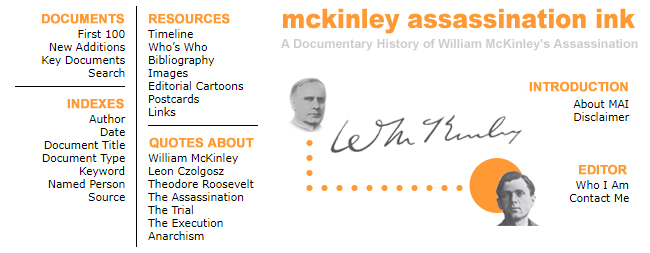|
How President McKinley Started His Great Buffalo
Speech
President McKinley’s great speech
at Buffalo grew from three phrases thought out by him one evening
in Canton while smoking his after-dinner cigar. This was three weeks
before he was to leave Canton for Buffalo on the visit which terminated
with his death.
The President and Secretary Cortelyou
were sitting together in the President’s office in his house. It
was seven o’clock and the lights had not yet been lighted. The President
sat quietly smoking, looking at the ceiling and watching the smoke
curl upward. Mr. Cortelyou sat across the desk from him, glancing
over some papers. Neither had said a word for ten minutes when suddenly
the President took his cigar from his lips and said, apropos of
nothing at all apparently:
“Expositions are the timekeepers of
progress.”
Mr. Cortelyou made a note of the epigram
on a bit of paper, but said nothing. The President smoked a few
minutes and then said:
“Amity is better than animosity.”
[138][139]
Mr. Cortelyou made another note. Mr.
McKinley lapsed back into his thoughtful mood. He puffed at his
cigar for a time and then again broke the silence:
“Reciprocity is better than retaliation.”
The President finished his cigar,
walked over and looked out of the window, returned and sat down
at his desk again, and then took up routine business with the secretary.
There was not a word between the President and the secretary about
the three phrases, but after the work was finished and the President
had gone in to see if Mrs. McKinley were comfortable, Mr. Cortelyou
went upstairs and had one of the stenographers typewrite the three
phrases, one at the top of the paper, one in the middle, and one
at the bottom. Next morning, before breakfast, Mr. Cortelyou took
the sheet of paper and put it on top of everything else on the President’s
desk. When Mr. McKinley came in he picked up the paper, read over
the epigrams and then, turning to Mr. Cortelyou, said with a smile:
“We have begun the Buffalo speech,
I see.”
The President expanded the three ideas
into the Buffalo speech. He did not use “Amity is better than animosity,”
or “Reciprocity is better than retaliation” in those exact words,
but that notable epigram, “Expositions are the timekeepers of progress”
went safely through all the revisions and attracted immediate attention
in the speech.
The President dictated little of the
speech. He wrote it out by paragraphs, taking fully two weeks to
do it. He used a pad on his knee on the porch, and also wrote some
of it while he was in Mrs. McKinley’s room. When he had it to his
liking he dictated it from his rough draft. Then he went over it
two or three times and polished it until it became the perfect piece
of composition it was when he delivered it.—N. Y. World.
|


![]()